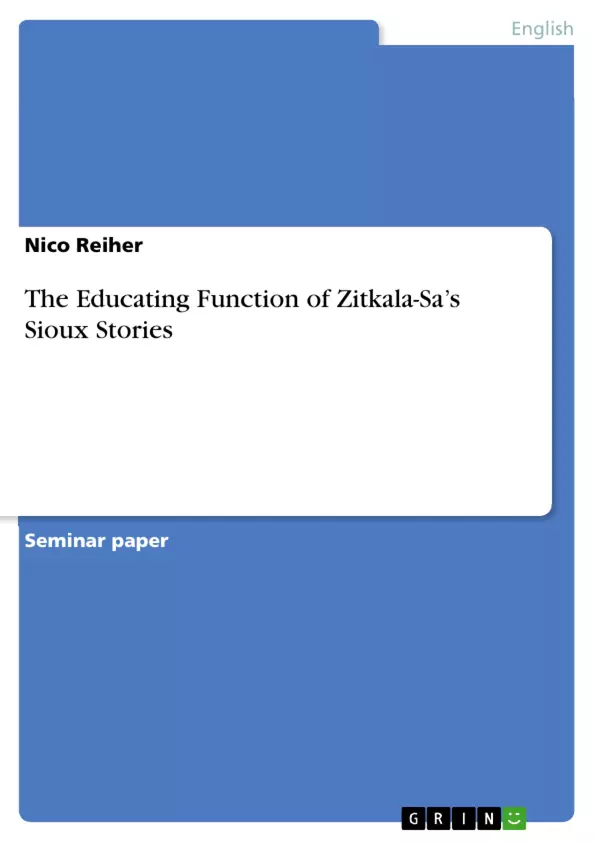What role does Native American oral literature play in the education of Native American children? What are the moral values and educational messages that can be found in short stories like Zitkala-Sa’s “Iktomi and the Ducks”? Are there significant differences from the lessons that non-Native literature teaches children? This paper approaches these different questions by referring to several characters and plots featured in the narratives by Zitkala-Sa. First of all, the didactic messages involved in the stories demand a categorization of the large number of different narratives as the second chapter of the paper examines. Besides the didactic messages, the traditional manners of storytelling also play an important role for Native American adults and children. Special ceremonial customs related to the act of storytelling need to be analyzed. The third chapter of this paper focuses on the particular characters and actual examples of how proper behavior is conveyed by either serving as good or bad examples. Furthermore, the paper investigates the degree of importance and the need for traditional tales in the context of educating Native children. The character of the Indian trickster plays an essential role in these processes. After having prospected these aspects, one might also be able to evaluate the usefulness of Zitkala-Sa’s Sioux stories for the education of non-Native children.
Inhaltsverzeichnis (Table of Contents)
- Introduction
- The Role of Indian Tales in the Education of Native American Children
- Manners of Storytelling
- Didactic Messages of the Stories
- The Educating Function of Iktomi and his Fellow Characters
- Iktomi, the Spider Fairy
- Iya, the Giant
- Old Double Face
- Manstin, the Rabbit
- Conclusion
Zielsetzung und Themenschwerpunkte (Objectives and Key Themes)
This paper investigates the role of Native American oral literature in the education of Native American children, focusing on the moral values and educational messages present in Zitkala-Sa's stories, such as "Iktomi and the Ducks." It explores the differences between these lessons and those taught through non-Native literature.
- Didactic messages in Native American stories
- Traditional manners of storytelling in Native American culture
- The role of specific characters in conveying proper behavior
- The importance of traditional tales in educating Native children
- The potential usefulness of Zitkala-Sa's Sioux stories for non-Native children
Zusammenfassung der Kapitel (Chapter Summaries)
The introduction explores the central question of the paper: What role do Native American oral traditions play in educating Native American children? It establishes the focus on Zitkala-Sa's stories and highlights the importance of understanding the didactic messages, storytelling customs, and character development within these narratives.
The second chapter delves into the significance of Native American tales in the education of Native American children. It examines the role of storytelling in Native American families and discusses the ceremonial aspects of the tradition. This chapter also explores how storytelling practices, such as the use of specific opening and closing formulas, contribute to the educational value of these narratives.
The third chapter focuses on the specific characters and plots featured in Zitkala-Sa's stories. It explores how these characters, both positive and negative, serve as examples of proper and improper behavior. This chapter analyzes the influence of characters like Iktomi, the Spider Fairy, and Iya, the Giant, on the educational messages conveyed through the stories.
Schlüsselwörter (Keywords)
This paper focuses on Native American oral literature, storytelling traditions, didactic messages, moral values, Native American children's education, character development, and the works of Zitkala-Sa.
- Quote paper
- Nico Reiher (Author), 2008, The Educating Function of Zitkala-Sa’s Sioux Stories, Munich, GRIN Verlag, https://www.grin.com/document/154983



